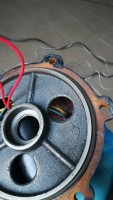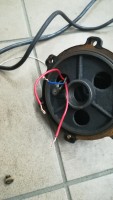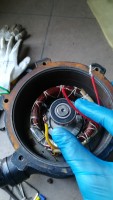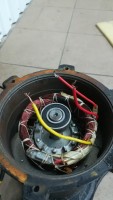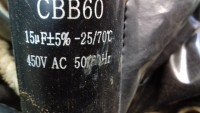FAQ
TL;DR: Humming single‑phase dirty‑water pump after loose wires? Confirm the 230 V feed—"Blue and brown protruding upwards are 230V." Then identify run/start by resistance before reconnecting. [Elektroda, nikusert, post #17134083]
Why it matters: This FAQ helps DIYers safely restore a submersible dirty‑water pump and avoid burnout after internal leads disconnected.
Quick Facts
- Supply leads: Blue and Brown are the 230 V AC mains on the shown pump. Treat them as live/neutral. [Elektroda, nikusert, post #17134083]
- Run (main) winding has lower resistance than the start (aux) winding. [Elektroda, nikusert, post #17134363]
- If colors don’t match, identify windings by measuring resistance with a multimeter. [Elektroda, nikusert, post #17133766]
- After reconnecting, verify it starts every time, doesn’t hum, and doesn’t heat up. [Elektroda, nikusert, post #17135472]
- A manual impeller nudge that gets it going points to a start‑circuit issue. [Elektroda, Piotrashd, post #17135448]
My pump hums after I reconnected wires—what should I check first?
Verify run vs start connections using resistance. The run winding should read lower ohms than the start winding. If swapped, the motor can hum instead of starting. As one expert noted, “the main winding has a lower resistance than the starting winding.” Correct the mapping, then retest. [Elektroda, nikusert, post #17134363]
Which wires are the 230 V feed in this setup?
On the referenced pump, the blue and brown wires are the 230 V supply leads. Connect them to mains as live and neutral respectively. Keep all connections insulated and strain‑relieved. Verify with a meter before powering. [Elektroda, nikusert, post #17134083]
How do I identify the windings with a multimeter?
Use this quick 3‑step check:
- Isolate the three motor leads and label them A, B, C.
- Measure resistance for AB, AC, and BC; note values.
- Use the distinct resistance pairs to identify each winding before reconnecting.
“The only solution is to measure the windings.” [Elektroda, nikusert, post #17133766]
Which winding goes through the capacitor?
The auxiliary (start) winding is powered via the capacitor. If the start circuit is open or miswired, the motor may only hum. Ensure the capacitor is in series with the auxiliary winding connection. [Elektroda, osiniak75, post #17133586]
The pump only starts if I spin the impeller. What does that indicate?
Needing a manual nudge suggests the start circuit or starting torque is weak. The OP reported nudging the grinder to get the pump running. That behavior is typical when the start path or capacitor isn’t engaged correctly. Recheck wiring and the capacitor. [Elektroda, Piotrashd, post #17135448]
After reconnecting, what safety check should I perform?
Verify it starts promptly, runs smoothly, and does not hum. Monitor temperature by touch on the housing. If it heats up, disconnect and recheck connections and winding IDs. Don’t let it run hot during tests. [Elektroda, nikusert, post #17135472]
Colors don’t match my pump. Can I rely on color codes?
Don’t rely on colors across brands. One member showed different colors than the OP’s pump and advised measurement. “The only solution is to measure the windings.” Use ohms readings to identify, not paint colors. [Elektroda, nikusert, post #17133766]
Can miswiring really damage the motor?
Yes. A miswired start/run circuit can cause prolonged humming and overheating. That stresses windings and can shorten motor life. If it hums or heats, stop and correct wiring before further tests. [Elektroda, nikusert, post #17135472]
How often should I exercise a seldom‑used dirty‑water pump?
The OP used the pump every 2 months and noted it wasn’t “tragically dirty.” Periodic exercising helps confirm starting and clears minor fouling. Test under supervision and recheck for smooth starts. [Elektroda, Piotrashd, post #17133039]
It hummed, then started by itself after a while. Is that okay?
That behavior was observed by the OP after reconnection. It can point to intermittent start engagement. Continue monitoring starts and stop if humming returns or heat rises. [Elektroda, Piotrashd, post #17135448]
What basic tools do I need to troubleshoot this?
Use a multimeter to measure winding resistances and continuity. Label wires, take clear photos, and insulate connections. Measuring is the decisive step when colors differ. [Elektroda, nikusert, post #17133766]
I replaced the capacitor and it still hums—what next?
If a known‑good capacitor didn’t fix it, verify winding identification and connections. The OP confirmed the capacitor was fine and planned to inspect windings next. [Elektroda, Piotrashd, post #17135498]



